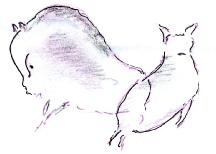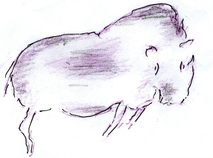



The Parish Church of St George the Martyr, Waterlooville

Whilst motoring through France and with folding bicycles in the car boot, Barbara and Rod stopped for a few days in the Dordogne. They were keen to see the caves of Cro-Magnon man (who succeeded the Neanderthals in that area around 17,000 years ago. The original intention was to visit the famous cave at Lascaux where marvellous paintings had been discovered, but it was closed to the public because of excessive interest, the breath of visitors having caused them to deteriorate. B & R had no wish to see the facsimiles which had been constructed, there being no substitute for ‘the real thing’.
B & R decided to look at the caves along the beautiful river Vésère, in the Périgord. They cycled the 12km by the river, pausing to look at the Grotte du Sourcier. Finding it temporarily closed they found a notice inviting them to go into the cave next door - Grotte Le Cluzeau. This involved a climb initially up steep stone steps, then from an ante-chamber up a ladder with a rope, and through a hole no wider than an adult. This cave was larger than a living room, with a rock aperture for a window. One feature was that water dripping from above could be collected in a carved receptacle. Altogether quite cosy and safe.
At nearby Les Eyzies they spent time in the museum of prehistory and then went to La Grotte de Font de Gaume where Cro-Magnon Man had covered the walls with over 230 figures, many in polychrome. They had actually arrived at the ticket office too late, as the day’s quota of attenders had been met. However, by a stroke of luck there had been two cancellations so they joined the afternoon guided tour.
This cave (Grotte) had depictions of the animals which roamed and were hunted at the time - bison, reindeer, mammoths, aurochs… At the museum it had been emphasised how near to Homo Sapiens these Cro-Magnon inhabitants of 14000-17000 years ago had been. They made wonderfully crafted tools and were skilful and resourceful hunters. Additionally, it was asserted, they were imaginative, and were the first artists.
Cave Men - Hunters and Artists
The cave is long and narrow, with wider parts suitable as rooms. The animal paintings show an astonishing power of observation, perspective and application. Some are single drawings whilst others are in groups. Earth pigments of manganese dioxide and iron oxide were used for colouring and shading. The contours of the rock facings were cleverly used to give a three-dimensional effect. It has been thought that, after outlining, the pigments were blown on by mouth through hollow bird bones to the surfaces. This is a remarkably similar process to modern airbrushing. The guide showed that, under flickering light the animals appeared to be in movement. The question is posed, ‘Why did the inhabitants of the caves do the paintings at all?’ It is conjectured with some plausibility that the Cro-Magnons depicted them for purely artistic reasons and possibly spiritual ones. Clearly a degree of intelligence beyond a purely animal level is shown.
The following day another cave was visited, that of Bara-Bahau in the village of Le Bugue. This one was vast in size, being like a cathedral. Some metres inside could clearly be seen marks where the original inhabitants, the bears, had sharpened their claws. High up on the walls were carvings etched into the rock, clearly depicting hunting scenes, and as grand in scope as the ones at Font de Gaume. Many hunting artefacts found there were on display. The scope and power of these etchings were awesome. Application here was of outlining the subject animals, since there were no suitable earth pigments available in this particular area.
The episode made a deep impression on B & R, who were delighted with their short but intellectually fulfilling stay in the Périgord.
Rod Dawson



Rod’s sketches of some animal paintings
found in La Grotte de Font-de-Gaume







